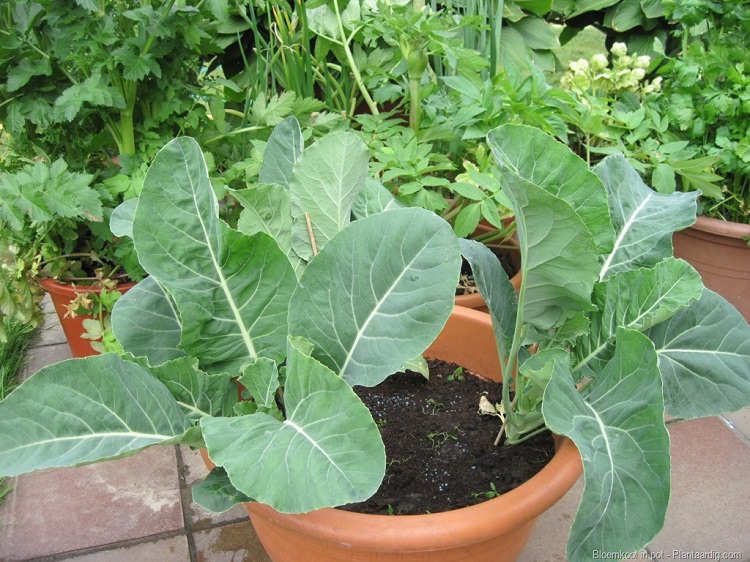Learn how to grow cauliflower in pots in this article. Growing cauliflowers in containers is not very difficult but rewarding–if you know all the details.

However, cauliflower is a cool-season crop, but there are many hybrid cultivars available for both temperate and tropical weather, which means it can be grown diversely in every climate.
How to Grow Cauliflower in Containers
Planting cauliflower in containers
It’s important to plant the variety that fits the season and climate you live in. Cauliflowers can be planted anytime in a frost-free climate when the temperature is between 50 and 85 F (10 and 30 C). When heads are maturing, the ideal temperature is around 60 to 70 F (15 to 20 C). This ensures the best flavor and growth.
Generally, in warmer regions (USDA Zone 9 – 11), you can start sowing cauliflower seeds in the fall and continue until the end of winter. In cooler zones, it’s better to start seeds from early spring to summer to get a summer or fall harvest.
If you’re planting cauliflower late in a cold climate, it’s important to note that the heads must not be exposed to frost when they are maturing.
Propagation
Sowing, transplanting, and planting are the same as for the cabbages. Sow the seeds in a seed starting mix, 1 or 2 cm deep and 4 cm apart. Once the seedlings germinated and plants have 3 or 4 leaves, you can start growing cauliflower in containers.
Choosing a Container
Choose a pot that is 12 inches deep and at least 10 to 12 inches wide to allow enough room for a plant to grow. Also, make sure it has enough drainage holes in the bottom. In such a pot, you can grow one plant.
You can also grow 2-3 cauliflower plants together in large buckets, half whiskey barrels, and even in sacks and grow bags.
Requirements for Growing Cauliflower in Containers
Position
Prefer to keep the pot in a sunny spot that receives a minimum of 6-8 hours of sunlight. In a really hot climate, growing this delicious vegetable in partial sun (4-6 hours) is also possible.
Soil
Like all brassicas, cauliflowers are quite demanding when it comes to soil. Fill the pot with quality potting soil that is light, deep, humus-rich, and slightly clayey. As cauliflower grows best in moist soil, choose a substrate that holds some moisture but also drains well. You can also add 1/4 part peat moss or coco peat in your commercial potting mix.
Watering
Because cauliflower grows in moist soil, you’ll need to water it regularly. It’s important to prevent the soil from drying during the seedling’s maturing period and head formation.
Drought-like conditions can lead to smaller or separate heads or even to their complete loss. Overwatering also impedes growth, which must be avoided.
Cauliflower Plant Care
When the head or flower (curd) of cauliflower becomes 2-3 inches in diameter (this is unnecessary for colored varieties), cover it with the inner leaves by breaking or tying them over the head. It is called blanching.
This will protect the head from the sun, and you’ll get healthy and beautiful white-colored and more flavorsome cauliflower after harvest.
Fertilizer
The cauliflower plant is a heavy feeder. You can mix compost or well-rotted manure into the soil at the time of planting. Additionally, side-dress the plant with a handful of compost or manure again in the middle of the growth.
If you’re not adding compost or not seeing the desired growth, fertilize it with balanced liquid fertilizer once a month or according to the product’s instructions.
Mulching
Mulching can be skipped when you’re growing cauliflower in containers. But you can do it to keep the soil cool and preserve moisture in the soil. In winter, mulching will keep the soil warm and insulate the roots from cold.
Pests and Diseases
Pests that damage the leaves–flea beetles, the larvae of cabbage butterflies, and moths love to feed on this plant. Aphids and whiteflies can infest it as well!
In diseases, it is infected by clubroot, which can be checked if quality soil is used. It also gets affected by powdery mildew. To prevent it, avoid wetting the foliage if it can’t dry out during the day.
Harvesting
The harvesting of cauliflower takes place virtually throughout the year, depending on the variety, sowing period, and climate. Generally, harvesting takes place about 3-4 months after planting.
You can check if cauliflower is ready for harvest when the head is fully developed (6 to 12 inches in diameter, depending more on the variety) and still compact. Once the blanching is done, you can harvest the cauliflower in 7-12 days.
Points to Remember
- Cauliflower heads (flowers) become ready for harvest in 3-5 months.
- It needs a moderately cool temperature range; around 60-75 F (15-25 C) is ideal.
- Too high or too cold temperatures lead to premature heading.
- Cauliflower requires a constant nutrient supply and slightly moist soil with an ideal pH of around 6.5-7.
- The key to growing cauliflowers is the right watering. Water carefully for the best result, and avoid either underwatering or overwatering.





I love cauliflower! Thanks for a great article
I recently transferred my cauliflower to a container (from a little cup), but I’m not sure if I planted it deep enough or to deep? Help!
Did you plant only two in a pot and got so many flowers or you planted more than two.?
Caefiol can also be a decoration not just eatable
I want to know about vegetable
Excellent app